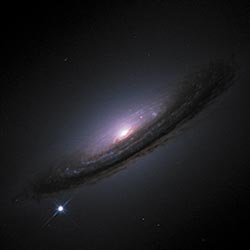
At its peak, a Type Ia supernova — the thermonuclear explosion of just one white dwarf — can outshine an entire galaxy. The Hubble Space Telescope captured this image of Type Ia Supernova 1994D in NGC 4526, a spiral galaxy in Virgo. The supernova is the bright 'star' in the lower-left corner.
Courtesy NASA and the High-Z Supernova Search Team.
Time and again, astronomers have been embarrassed by the fact that they don't really understand one of their most important tools, Type Ia supernovae, which serve as invaluable "standard candles" for measuring cosmic distances. But if new work announced yesterday at the American Astronomical Society meeting in Atlanta, Georgia, holds up, they may have taken a big step in the right direction.
Because they can be used to measure distances as great as several billion light-years, Type Ia supernovae have enabled cosmologists to gauge how fast the universe is expanding and how the expansion rate has changed through time. Six years ago, the exploding stars provided the first evidence that the universe's expansion has been speeding up, due to an all-pervasive "dark energy" that no one expected. Type Ia supernovae also affect our daily lives: most of the iron in everything from frying pans to steel girders was forged within these stellar furnaces.
But what are Type Ia supernovae, exactly? Specialists have argued for some time that a Type Ia supernova happens when a white dwarf (the bare, crystalline core of a very old, low-mass star) turns into a giant thermonuclear bomb. This should occur, they say, if a close companion star dumps a significant amount of matter onto the white dwarf. As the density and temperature increase in the dwarf's interior, carbon nuclei located there suddenly fuse to form nickel and iron, releasing energy in a runaway explosion that blows the entire star apart.

If the components of a low-mass binary star orbit one another too closely, the system is doomed: after one star evolves into a white dwarf, it eventually will pull matter from its companion — and sooner or later the dwarf will explode when fusion reactions run away in its core.
S&T / Gregg Dinderman
So far, so good. But theorists have had nagging problems identifying how a white dwarf can collect enough infalling mass to go "critical" without first blowing it all away. That's because when fresh hydrogen gathers on a white dwarf's surface, it is likely to have a thermonuclear explosion of its own. The result of such a premature eruption is an ordinary "classical" nova, which leaves the dwarf stripped of its fresh new layer — and probably some of its underlying matter as well. Over the ages, repeated nova blasts should erode the star, so that infalling hydrogen actually will make it lose rather than gain mass.
Now a team of astronomers claims to have the situation figured out. "We have identified the type of star that explodes in a Type Ia supernova," declared Sumner Starrfield (Arizona State University) yesterday in a press conference at the Atlanta meeting. The culprit, he says, is a special type of binary-star system known as a "supersoft X-ray source."
The white dwarf in a supersoft X-ray source is so hot (anywhere from 500,000° to 700,000° Celsius) that it emits copious X-rays (albeit of the relatively low-energy, or "soft," variety) — hence the name. Once a white dwarf in one of these systems gets hot enough, says Starrfield, it can fuse infalling hydrogen (making helium) continuously — as soon as the gas lands on its surface — rather than allowing it to sit around and built up for a novalike blowoff. In turn, the hydrogen-to-helium fusion provides a huge amount of energy to keep the star broiling.
Using computer simulations, Starrfield and his colleagues have followed a superhot white dwarf's evolution as it approaches the brink of supernova eruption. In addition to hydrogen fusing to make helium in the star's "skin" (the top 1 kilometer), the helium fuses deeper down to form carbon and other heavy elements, says Starrfield, with the mix "depending on how fast the infalling material arrives."
This fusion-on-contact scenario explains another Type Ia conundrum. Nearly everything in the universe consists mostly of hydrogen, including the infalling stream of gas that overloads the dwarf. But virtually no Type Ia supernovae show hydrogen (or helium) in their spectra. Starrfield's models explain this naturally by getting rid of the hydrogen as soon as it lands — and then the helium soon thereafter.
 0
0
Comments
You must be logged in to post a comment.